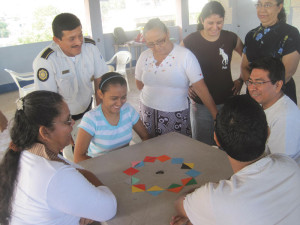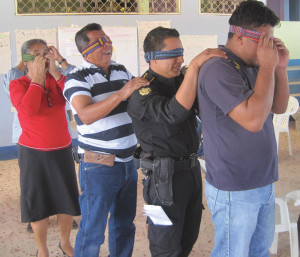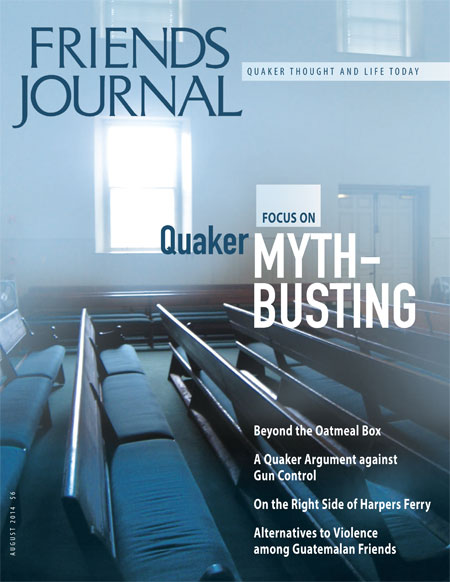
Can two gringa women from New England traveling to Guatemala hope to offer anything to Quakers to help them deal with the violence in their communities? What could we possibly have to share that would be helpful to them? How could we even understand what they are dealing with every day, the violence to which they are victim, due at least partly to our government’s inept handling of the illegal drug trade and its history of criminal meddling in the affairs of that country?
These were questions my friend Minga Claggett-Borne and I held in our hearts as we weighed an invitation from Guatemalan Friends for this travel ministry. Our only claim to legitimacy is that we were asked to go, in order to help organize workshops against violence and bring new energy to a program that was already well underway due to the work of Guatemalans and of the international Quaker program supporting the work of the Alternatives to Violence Project (AVP).
After much prayer and discernment through our clearness committees and the national AVP network, we decided to go. We had plans to offer an energetic schedule of four workshops over three weekends. The goal was to jumpstart the training of AVP among Friends in Guatemala. The program has been ably offered in Guatemala for years, but this would be the first time it was brought to the Quaker communities which are strong in the east of the country, a city and department called Chiquimula.
At the end, a full 55 certificates of completion were earned, each for a 20-hour workshop. There was much laughter and sharing, and deep work on family relationships was done. Our hosts and organizers, Celeste Gomez in Ipala and Karen Gregorio in Chiquimula, devoted incredible efforts to bringing people together and making the workshops happen. The participants each gave a full weekend to the work with positive energy and commitment, setting aside their other obligations to be there, fully present. Participants committed to continue the work, to pass the training on in other groups. We talked about the program on TV, in meetings and churches, and to individuals, all of whom showed an interest in using the program to try to bring peace to their communities.
What I can say is that it turned out to be a time of tremendous learning for me personally. I hope and pray that it will be of some use for the participants in the program. I always learn more about myself when I offer AVP, especially how to communicate better and how to work better with others. In these workshops, I learned most in two areas: how AVP works with Quaker participants, and how the concept of nonviolence is understood in a country like Guatemala, with one of the highest homicide rates in the world.
My experience with AVP had been mostly in prisons, with non-Quaker participants, but in these workshops the participants were members of the Guatemalan Evangelical Friends community. The curriculum is non-religious, though it has spiritual elements in the same way that the 12-step program does. The core of the program is to discover how to call on “transforming power” to shift and resolve conflicts. In these workshops where most of the participants are practicing Quakers and strong Christians, I wondered whether they would follow our lead to be inclusive in their language, or whether they would refer to their Christian values which are an enormous part of their lives. In fact, they generally chose to use non-religious language in the program, despite the fact that most participants were Quakers. Some of them told us that they appreciated this more inclusive language and felt that it would be useful in non-Quaker groups where they planned to use AVP, such as universities, workplaces, and police departments.
 Despite our shared Quaker background, cultural differences between us and our Guatemalan host community were apparent. One of those differences came up around corporal punishment of children. Most of the Guatemalans believe in spanking their children as a form of discipline. So for me, the question arose: should I label spanking as violent, share my own viewpoint gently, or leave this unchallenged? My sense of integrity generally called for me to share my own viewpoint that physical punishment of kids is rooted in violence and is not helpful to building peaceful families. But when we visited a pastor, his wife showed us how she threatens to hit her three-year-old with a wooden spoon. She asked the older brother to “go get the paddle,” and she proudly showed us how the little brother immediately changed his behavior. I did not tell her I disagreed with this policy. Was it because I was in her home, and she was about to serve us lunch? I don’t know. Perhaps it’s not useful to call out all of our disagreements. Maybe more is to be gained by noting all the ways in which we agree despite our differences.
Despite our shared Quaker background, cultural differences between us and our Guatemalan host community were apparent. One of those differences came up around corporal punishment of children. Most of the Guatemalans believe in spanking their children as a form of discipline. So for me, the question arose: should I label spanking as violent, share my own viewpoint gently, or leave this unchallenged? My sense of integrity generally called for me to share my own viewpoint that physical punishment of kids is rooted in violence and is not helpful to building peaceful families. But when we visited a pastor, his wife showed us how she threatens to hit her three-year-old with a wooden spoon. She asked the older brother to “go get the paddle,” and she proudly showed us how the little brother immediately changed his behavior. I did not tell her I disagreed with this policy. Was it because I was in her home, and she was about to serve us lunch? I don’t know. Perhaps it’s not useful to call out all of our disagreements. Maybe more is to be gained by noting all the ways in which we agree despite our differences.
Minga and I stayed with some wonderful Quakers in Chiquimula during the workshops and on our brief foray into Honduras. It was a gift to get to know these Quakers, to share their lives, and to learn about their belief systems. Guatemalan Friends have three yearly meetings, occasioned by some disagreements in policy that led to various splits. The Santidad yearly meeting split off from the Nacional with a strong concern to return to practices of the early Friends: separate worship for men and women was among the changes they chose. The third yearly meeting, Embajadores, is very small. All three groups are evangelical Christian in orientation. Their worship services are programmed with pastors offering the service, unlike the unprogrammed tradition in which both Minga and I worship. The women generally wear skirts to meeting, and jewelry and dancing are frowned upon. In their personal lives, the Quakers we met call on their faith frequently, and many of them prefer Christian radio stations and entertainment. Music is a huge part of their services, and I rejoiced to hear the beautiful harmonies of a mother-and-daughter pair, as well as the beautiful, clear voice of Karen’s nephew, who has recorded a CD to sing of his love of Jesus. Sharing our own truth as Quakers and discussing openly our similarities and differences with our evangelical Quaker hosts became important parts of this travel ministry.
Besides the opportunity to offer the workshops to a mostly Quaker audience, the other new learning for me was the impact of offering the workshops in Guatemala, where violence is continually present as an undercurrent and state-sponsored violence is rampant. The participants and facilitators alike were surprised that two police officers signed up to participate in the workshop. The national police force is vastly underpaid and carries a history of violence against the people. This violence is a legacy of U.S. imperialism dating back to the CIA-sponsored coup of President Jacobo Árbenz Guzmán in 1954, with a cruel resurgence during the genocide of indigenous people in the 1980s. The illegal drug trade and poverty in general have increased the occurrence of violence in the last decade. Police are seen as either impotent or dangerous, or both. To say there is a lack of trust is a major understatement. There are reports of police involvement in petty as well as organized crime. Stories of police stealing from citizens during traffic stops are rampant. In fact, one friend told us that when he was stopped by the police, he called his lawyer and told the police, “My lawyer is on the phone and is recording what happens here,” after which the officer sent him on his way without further questions.
 The history of Guatemala during the genocide continues to hang over the country, which has yet to fully bring the perpetrators to justice. This violence, referred to as the Civil War or the Genocide, depending on one’s point of view, resulted in 200,000 killed and 40,000 to 50,000 disappeared. Of these, the United Nations-sponsored Historical Clarification Commission (or CEH based on the Spanish translation) stated that the state was responsible for 93 percent of the human rights violations committed during the war and the guerrillas for 3 percent. We were told that the region where we would be spending most of our time, the eastern city of Chiquimula, was deeply afflicted by drug-related violence.
The history of Guatemala during the genocide continues to hang over the country, which has yet to fully bring the perpetrators to justice. This violence, referred to as the Civil War or the Genocide, depending on one’s point of view, resulted in 200,000 killed and 40,000 to 50,000 disappeared. Of these, the United Nations-sponsored Historical Clarification Commission (or CEH based on the Spanish translation) stated that the state was responsible for 93 percent of the human rights violations committed during the war and the guerrillas for 3 percent. We were told that the region where we would be spending most of our time, the eastern city of Chiquimula, was deeply afflicted by drug-related violence.
Our experience on the ground was mostly very peaceful. People walked and drove around day and night in Chiquimula without worries, and our hosts frequently left their door open during the daytime. Many participants said they have no violence in their homes, and indeed most of them are lucky not to have had any murder victims in the family. But all of them experience the effects of living in a country weighed down by a history of oppression and violence, from abroad and from within, including its colonial history of oppression by the light-skinned Spanish and continual oppression of its Mayan peoples, who constitute 50 percent of the population. The current president, Otto Pérez Molina, was a military general during the time of the genocide, and he denies that genocide took place. He was elected on a platform of law and order, and indeed there are reports that violence has declined. But random violence is still a daily occurrence. Our co-facilitators took major risks in traveling by public bus to the workshops. Theft is very common. Travel at night is foolhardy. We observed some of the effects of the society-wide violence on our last day in Guatemala. On our way to the airport, traffic was paralyzed as a result of the murder of two police officers elsewhere in Guatemala City.
There are efforts to clean up the police force and one of these is called Valor y Servicio, translated as “valor and service.” This branch of the force is working to change the police force from within. The two police officers in our workshops came from this branch. They were on duty, so they arrived with their pistols and handcuffs, an unusual sight at an AVP workshop. They participated in both the first- and second-level workshops over two weekends, and the group became more comfortable with them over time. Societal differences between police officers and citizens broke down, and we all saw them as individuals. On the last day of our workshop, we offered an exercise called Human to Human. In this exercise participants form pairs and one member of each pair closes his or her eyes, while the other one looks at his or her partner in compassion. When we first began the exercise, some of the participants had a hard time even keeping their gaze on their partner, especially those who were partnered with the police officers. However, at the end, when both partners open their eyes and continue to gaze at each other with the acceptance of universal love, the faces had softened considerably. Many participants were teary. It was a remarkable experience.
Our workshop took place in a Quaker church in a tough neighborhood where teen parenting and unemployment were rampant. The air was acrid with the smell of burning garbage, since the area residents cannot afford the fee for garbage removal. The concept of nonviolence in personal communication would have been very foreign to most of the church’s neighbors. The workshop participants came from the wider community, and they were very open to looking at the connections between violence in their personal communications and making peace in the larger world. The church chose to be based in this neighborhood and to work with the local people on various projects. It made me think: How many of our Quaker meetings have moved out of poor communities when it became hard to be there?
What does nonviolence mean in the context of a society nearly paralyzed by violence on a larger societal level? Can we really ask people to take a stand for a more peaceful nation when they cannot trust the justice system? Can Quakers succeed in helping their poor neighbors develop skills and resources when community-based organizations and social services are lacking? Or should we hope that by showing people tools for communicating more peacefully in their personal lives, collectively we will have a greater impact on the society as a whole? As one observer visiting another culture, I would not presume to tell anyone how to use the tools we offered in the Alternatives to Violence workshops. I can only offer the tools and pray that they will be useful in some way. Our experience of walking hand in hand with our Guatemalan Friends was humbling. They show much bravery and a rock-solid faith in a God who is always present despite their many daily hardships and challenges.



Comments on Friendsjournal.org may be used in the Forum of the print magazine and may be edited for length and clarity.